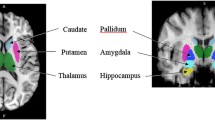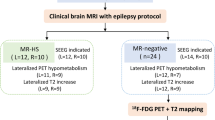Abstract
Objectives
To investigate the diagnostic capability of anterior temporal lobe white matter abnormal signal (ATLAS) for determining seizure focus laterality in temporal lobe epilepsy (TLE) by comparing different MR sequences.
Methods
This prospective study was approved by the institutional review board and written informed consent was obtained. Three 3D sequences (double inversion recovery (DIR), fluid-attenuated inversion recovery (FLAIR) and T2-weighted imaging (T2WI)) and two 2D sequences (FLAIR and T2WI) were acquired at 3 T. Signal changes in the anterior temporal white matter of 21 normal volunteers were evaluated. ATLAS laterality was evaluated in 21 TLE patients. Agreement of independent evaluations by two neuroradiologists was assessed using κ statistics. Differences in concordance between ATLAS laterality and clinically defined seizure focus laterality were analysed using McNemar’s test with multiple comparisons.
Results
Pre-amygdala high signals (PAHS) were detected in all volunteers only on 3D-DIR. Inter-evaluator agreement was moderate to almost perfect for each sequence. Correct diagnosis of seizure laterality was significantly more frequent on 3D-DIR than on any other sequences (P ≤ 0.031 for each evaluator).
Conclusions
The most sensitive sequence for detecting ATLAS laterality was 3D-DIR. ATLAS laterality on 3D-DIR can be a good indicator for determining seizure focus localization in TLE.
Key Points
• Magnetic resonance imaging is widely used to investigate temporal lobe epilepsy.
• Numerous MR sequences can show anterior temporal lobe white matter abnormal signal.
• ATLAS on 3D-DIR can frequently indicate seizure focus laterality in TLE.
• 3D-DIR is more sensitive about ATLAS laterality than T2WI or FLAIR.



Similar content being viewed by others
Abbreviations
- ATLAS:
-
anterior temporal lobe white matter abnormal signal
- CSF:
-
cerebrospinal fluid
- DIR:
-
double inversion recovery
- EEG:
-
electroencephalography
- FLAIR:
-
fluid-attenuated inversion recovery
- MR:
-
magnetic resonance
- PAHS:
-
pre-amygdala high signals
- TLE:
-
temporal lobe epilepsy
- T2WI:
-
T2-weighted imaging
- 2D:
-
two-dimensional
- 3D:
-
three-dimensional
References
Semah F, Picot MC, Adam C et al (1998) Is the underlying cause of epilepsy a major prognostic factor for recurrence? Neurology 51:1256–1262
Wiebe S, Blume WT, Girvin JP, Eliasziw M (2001) A randomized, controlled trial of surgery for temporal-lobe epilepsy. N Engl J Med 345:311–318
Choi H, Sell RL, Lenert L et al (2008) Epilepsy surgery for pharmacoresistant temporal lobe epilepsy: a decision analysis. JAMA 300:2497–2505
Schorner W, Meencke HJ, Felix R (1987) Temporal-lobe epilepsy: comparison of CT and MR imaging. AJR Am J Roentgenol 149:1231–1239
Wetjen NM, Marsh WR, Meyer FB et al (2009) Intracranial electroencephalography seizure onset patterns and surgical outcomes in nonlesional extratemporal epilepsy. J Neurosurg 110:1147–1152
Hamer HM, Morris HH, Mascha EJ et al (2002) Complications of invasive video-EEG monitoring with subdural grid electrodes. Neurology 58:97–103
Engel J, Cascino GD, Shieleds WD (2008) Surgically remediable syndromes. In: Engel J, Pedley TA, Aicardi J (eds) Epilepsy: a comprehensive textbook, 2nd edn. Lippincott Williams & Wilkins, Philadelphia, pp 1761–1769
King MA, Newton MR, Jackson GD et al (1998) Epileptology of the first-seizure presentation: a clinical, electroencephalographic, and magnetic resonance imaging study of 300 consecutive patients. Lancet 352:1007–1011
Coste S, Ryvlin P, Hermier M et al (2002) Temporopolar changes in temporal lobe epilepsy: a quantitative MRI-based study. Neurology 59:855–861
Kuzniecky R, de la Sayette V, Ethier R et al (1987) Magnetic resonance imaging in temporal lobe epilepsy: pathological correlations. Ann Neurol 22:341–347
Adachi Y, Yagishita A, Arai N (2006) White matter abnormalities in the anterior temporal lobe suggest the side of the seizure foci in temporal lobe epilepsy. Neuroradiology 48:460–464
Mitchell LA, Jackson GD, Kalnins RM et al (1999) Anterior temporal abnormality in temporal lobe epilepsy: a quantitative MRI and histopathologic study. Neurology 52:327–336
Choi D, Na DG, Byun HS et al (1999) White-matter change in mesial temporal sclerosis: correlation of MRI with PET, pathology, and clinical features. Epilepsia 40:1634–1641
Schijns OE, Bien CG, Majores M et al (2011) Presence of temporal gray-white matter abnormalities does not influence epilepsy surgery outcome in temporal lobe epilepsy with hippocampal sclerosis. Neurosurgery 68:98–106, discussion 107
Meiners LC, Witkamp TD, de Kort GA et al (1999) Relevance of temporal lobe white matter changes in hippocampal sclerosis. Magnetic resonance imaging and histology. Invest Radiol 34:38–45
Briellmann RS, Jackson GD, Pell GS, Mitchell LA, Abbott DF (2004) Structural abnormalities remote from the seizure focus: a study using T2 relaxometry at 3 T. Neurology 63:2303–2308
Townsend TN, Bernasconi N, Pike GB, Bernasconi A (2004) Quantitative analysis of temporal lobe white matter T2 relaxation time in temporal lobe epilepsy. NeuroImage 23:318–324
Turetschek K, Wunderbaldinger P, Bankier AA et al (1998) Double inversion recovery imaging of the brain: initial experience and comparison with fluid attenuated inversion recovery imaging. Magn Reson Imaging 16:127–135
Geurts JJ, Pouwels PJ, Uitdehaag BM, Polman CH, Barkhof F, Castelijns JA (2005) Intracortical lesions in multiple sclerosis: improved detection with 3D double inversion-recovery MR imaging. Radiology 236:254–260
Zhang Q, Li Q, Zhang J, Zhang Y (2011) Double inversion recovery magnetic resonance imaging (MRI) in the preoperative evaluation of hippocampal sclerosis: correlation with volumetric measurement and proton magnetic resonance spectroscopy ((1)H MRS). J Comput Assist Tomogr 35:406–410
Rugg-Gunn FJ, Boulby PA, Symms MR, Barker GJ, Duncan JS (2006) Imaging the neocortex in epilepsy with double inversion recovery imaging. NeuroImage 31:39–50
Salmenpera TM, Symms MR, Rugg-Gunn FJ et al (2007) Evaluation of quantitative magnetic resonance imaging contrasts in MRI-negative refractory focal epilepsy. Epilepsia 48:229–237
Mugler JP 3rd, Bao S, Mulkern RV et al (2000) Optimized single-slab three-dimensional spin-echo MR imaging of the brain. Radiology 216:891–899
Langlotz CP (2003) Fundamental measures of diagnostic examination performance: usefulness for clinical decision making and research. Radiology 228:3–9
Cotton F, Rambaud L, Hermier M (2006) Dual inversion recovery MRI helps identifying cortical tubers in tuberous sclerosis. Epilepsia 47:1072–1073
Wattjes MP, Lutterbey GG, Gieseke J et al (2007) Double inversion recovery brain imaging at 3T: diagnostic value in the detection of multiple sclerosis lesions. AJNR Am J Neuroradiol 28:54–59
Carrete H Jr, Abdala N, Lin K et al (2007) Temporal pole signal abnormality on MR imaging in temporal lobe epilepsy with hippocampal sclerosis: a fluid-attenuated inversion-recovery study. Arq Neuropsiquiatr 65:553–560
Cavazos JE, Sutula TP (1990) Progressive neuronal loss induced by kindling: a possible mechanism for mossy fiber synaptic reorganization and hippocampal sclerosis. Brain Res 527:1–6
Powell TP, Cowan WM, Raisman G (1965) The central olfactory connexions. J Anat 99:791–813
Herzog AG, Van Hoesen GW (1976) Temporal neocortical afferent connections to the amygdala in the rhesus monkey. Brain Res 115:57–69
Zhang Z, Yip CY, Grissom W, Noll DC, Boada FE, Stenger VA (2007) Reduction of transmitter B1 inhomogeneity with transmit SENSE slice-select pulses. Magn Reson Med 57:842–847
Bock JC, Neumann K, Sander B, Schmidt D, Schorner W (1991) [Prepontine artifacts due to cerebrospinal fluid pulsation in the T-2 weighted coronal MRT picture. Clinical significance, frequency, technique for artifact suppression]. Rofo 154:202–205
Naganawa S, Koshikawa T, Nakamura T et al (2004) Comparison of flow artifacts between 2D-FLAIR and 3D-FLAIR sequences at 3 T. Eur Radiol 14:1901–1908
Acknowledgements
We wish to thank Mr. Katsutoshi Murata and Mr. Masato Uchikoshi, of Siemens Japan K.K., for their contributions to the optimization of scan parameters.
Author information
Authors and Affiliations
Corresponding author
Rights and permissions
About this article
Cite this article
Morimoto, E., Kanagaki, M., Okada, T. et al. Anterior temporal lobe white matter abnormal signal (ATLAS) as an indicator of seizure focus laterality in temporal lobe epilepsy: comparison of double inversion recovery, FLAIR and T2W MR imaging. Eur Radiol 23, 3–11 (2013). https://doi.org/10.1007/s00330-012-2565-4
Received:
Revised:
Accepted:
Published:
Issue Date:
DOI: https://doi.org/10.1007/s00330-012-2565-4




